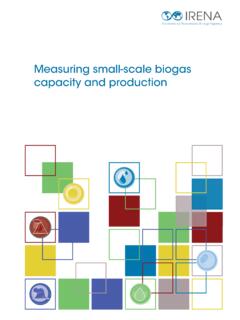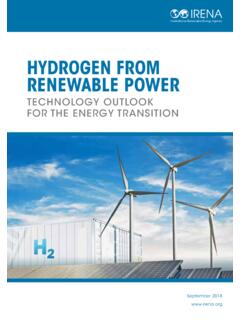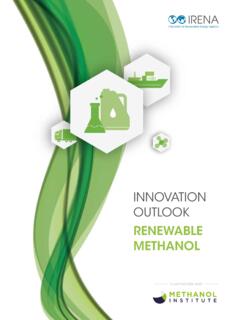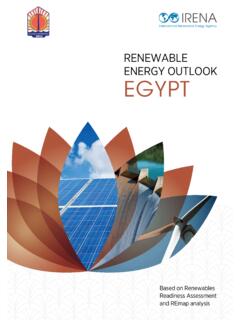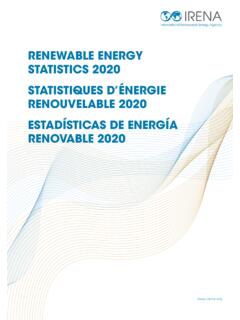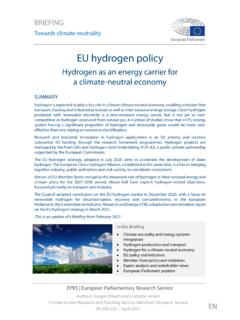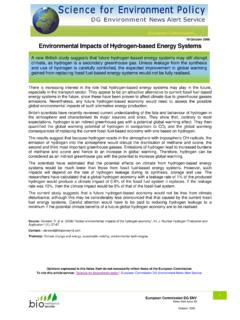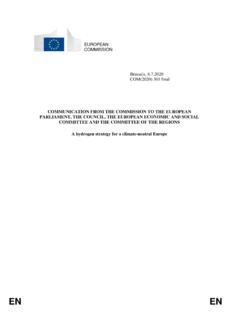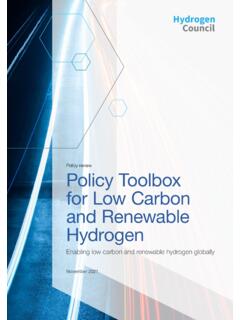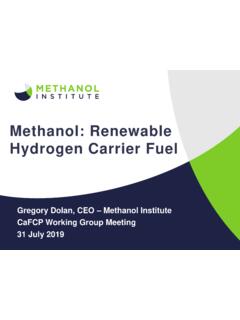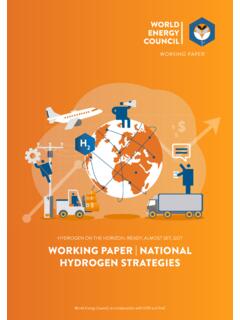Transcription of GREEN HYDROGEN SUPPLY
1 GREENHYDROGENSUPPLYA GUIDE TO policy MAKING IRENA 2021 Unless otherwise stated, material in this publication may be freely used, shared, copied, reproduced, printed and/or stored, provided that appropriate acknowledgement is given of IRENA as the source and copyright holder. Material in this publication that is attributed to third parties may be subject to separate terms of use and restrictions, and appropriate permissions from these third parties may need to be secured before any use of such : IRENA (2021), GREEN HYDROGEN SUPPLY : A guide to policy making, International Renewable Energy Agency, Abu : 978-92-9260-344-1 ABOUT IRENAThe International Renewable Energy Agency (IRENA) serves as the principal platform for international co-operation, a centre of excellence, a repository of policy , technology, resource and financial knowledge, and a driver of action on the ground to advance the transformation of the global energy system.
2 An intergovernmental organisation established in 2011, IRENA promotes the widespread adoption and sustainable use of all forms of renewable energy, including bioenergy, geothermal, hydropower, ocean, solar and wind energy, in the pursuit of sustainable development, energy access, energy security and low-carbon economic growth and prosperity. report was authored by Emanuele Bianco, Diala Hawila and Herib Blanco under the guidance of Rabia Ferroukhi. IRENA colleagues Roland Roesch, Stephanie Weckend, Kelly Tai, Barbara Jinks, Masashi Hoshino, Sufyan Diab and Abdullah Abou Ali provided valuable input. Massimo Santarelli, Marta Gandiglio and Flaviano Volpe (Polytechnic University of Turin) provided technical contributions to the report.
3 Jekaterina Boening (European Federation for Transport and Environment) and C dric Philibert provided important and welcomed contributions and observations. The report benefited also from the reviews and comments of experts in separate rounds, including Matthias Deutsch (Agora Energiewende), Yanming Wan (China HYDROGEN Alliance), Frank Wouters (EU-GCC Clean Energy Technology Network), Ruud Kempener (European Commission DG Energy), Antonello di Pardo (GSE ), Yanfei Li (Hunan University of Technology and Business), Jose Miguel Bermudez and Peerapat Vithayasrichareon (IEA), Marta Martinez (Iberdrola), Pierpaolo Cazzola and Matteo Craglia (ITF), Subrahmanyam Pulipaka (National Solar Energy Federation of India), Karl Hauptmeier (Norsk e-Fuel), Duncan Gibb and Hannah Murdock (REN21), Thierry Lepercq (Soladvent)
4 , Hergen Thore Wolf (Sunfire GmbH), Kirsten Westphal (SWP), Ad van Wijk (TU Delft), Rina Bohle Zeller and Andrew Gordon Syme Mcintosh (Vestas), Sripathi Anirudh, Kajol and Deepak Krishnan (World Resources Institute).Available for download: further information or to provide feedback: publication and the material herein are provided as is . All reasonable precautions have been taken by IRENA to verify the reliability of the material in this publication. However, neither IRENA nor any of its officials, agents, data or other third-party content providers provides a warranty of any kind, either expressed or implied, and they accept no responsibility or liability for any consequence of use of the publication or material herein.
5 The information contained herein does not necessarily represent the views of all Members of IRENA. The mention of specific companies or certain projects or products does not imply that they are endorsed or recommended by IRENA in preference to others of a similar nature that are not mentioned. The designations employed, and the presentation of material herein, do not imply the expression of any opinion on the part of IRENA concerning the legal status of any region, country, territory, city or area or of its authorities, or concerning the delimitation of frontiers or GUIDE TO policy MAKING3 CONTENTS INTRODUCTION 06 About this report 08 1. CURRENT STATUS AND CHALLENGES 11 Current status 11 HYDROGEN SUPPLY barriers 152 2.
6 policy OPTIONS 23 Policies to support electrolyser deployment 25 Policies to ensure electricity is sustainable and to support its cost-competitiveness 29 Policies to incentivise GREEN HYDROGEN demand 34 Policies to support HYDROGEN infrastructure 43 Research and development support 472 3. THE WAY FORWARD 49 The policy stages 49 Conclusion 53 ANNEX Water electrolysis technologies 54 References 56 Abbreviations 62 Photo credits 634 TABLE OF CONTENTFIGURESF igure GREEN HYDROGEN value chain and the focus of this report 08 Figure Volumetric energy density of various solutions to transport HYDROGEN 14 Figure HYDROGEN production cost depending on electrolyser system cost.
7 Electricity price and operating hour 16 Figure Costs for HYDROGEN transport as a function of the distance by selected transport mode 18 Figure Barriers and policy options for the SUPPLY of GREEN HYDROGEN 24 Figure Electrolyser capacity targets in European HYDROGEN strategies, 2030 26 Figure Production models 29 Figure Industrial electricity prices by component, in selected European countries, 2019 32 Figure Correlation between levelised cost of HYDROGEN and operating hours of a grid-connected electrolyser, western Denmark, 2019 33 Figure CO2 benefit and gas price increase from blending and converting the gas grid to HYDROGEN 38 Figure Envisaged trade routes for HYDROGEN as of 2021 41 Figure Range of policies to promote electrolysis across three stages of deployment 51 BOXESBox IRENA s work on GREEN HYDROGEN and hard-to-abate sectors 10 Box Selected announcements of electrolyser projects 12 Box Selected announcements of projects to expand electrolyser manufacturing 13 Box Energy losses of the HYDROGEN SUPPLY technologies 19 Box Estimated cost of HYDROGEN from a grid-connected electrolyser in Denmark 33 Box The Netherlands SDE++ scheme 36 Box Blending HYDROGEN in fossil gas grids 38 Box Japan
8 S strategy for demonstrating diverse value chains 42 Box policy stages for electrolysis and infrastructure 50 TABLEST able A .1 Water electrolysis technologies as of today 555 INTRODUCTIONIn the 2015 Paris Agreement, nations around the world agreed that rapid decarbonisation is needed to prevent the dangerous impacts of climate change. Then in 2018, the Intergovernmental Panel on Climate Change (IPCC) report Global Warming of C showed that the need to cut greenhouse gas (GHG) emissions rapidly is even more urgent than previously thought (IPCC, 2018a). The report concluded that the window of opportunity is closing fast for meaningful action to limit the planet s increase in temperature and to counter the global climate crisis.
9 Therefore, policy makers must increase their efforts to reduce or eliminate emissions in all economic activities. Options that would deliver only partial emission reductions are not full decarbonisation of some industry and transport subsectors is technically and economically challenging, and the current number of solutions is limited. These are known as hard-to-abate sectors. There is, however, a common solution for some of these hard-to-abate sectors: HYDROGEN produced with renewable energy, also known as GREEN HYDROGEN . GREEN HYDROGEN can be used as a feedstock for the production of chemicals and fuels or directly as a was predictable, then, that GREEN HYDROGEN should receive a new wave of attention from governments, policy makers, energy sector stakeholders and even the general public.
10 An unprecedented number of reports, news articles, webinars and events in the last two years have touched upon the topic. But the development of a GREEN HYDROGEN sector is itself still at a very early stage. Each year around 120 million tonnes (Mt) of HYDROGEN are produced globally, mostly from fossil gas and coal (grey HYDROGEN ), which together account for 95% of global production. HYDROGEN used for crude oil refining and for ammonia and methanol synthesis represent almost 75% of HYDROGEN consumption. The roadmap described in IRENA s World Energy Transitions Outlook includes a major role for GREEN HYDROGEN in reducing GHG emissions and making the energy transition possible.
